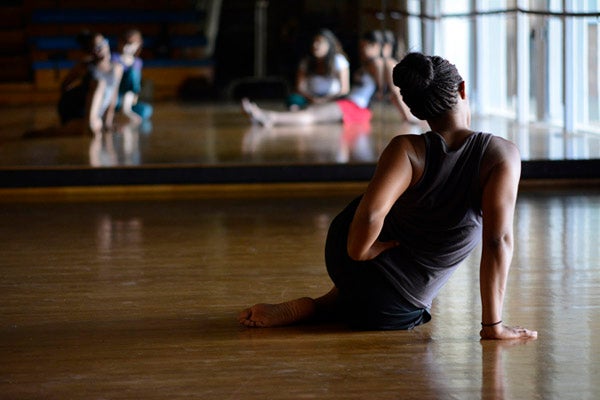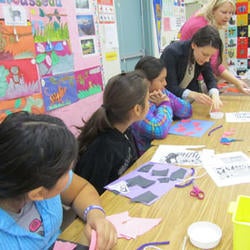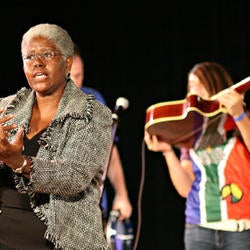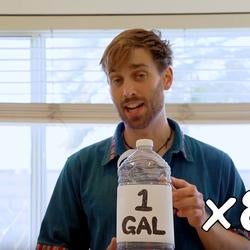Gluck Creative Classroom - Dance
Dance Africa
|
An Ka Taa! Let's Go!: A Dance Voyage Through Africa By using this Digital DIY Curriculum, students will learn: a few greetings in the local language of each destination on our “voyage,” how to identify each country on the map, an interesting fact about the region, and the name, context, and fundamental dance steps of a traditional dance practiced in that country. DOWNLOADS: An Ka Taa! Lets Go! A Dance Voyage Through Africa Introduction.pdf |
|
An Ka Taa! (Let's Go!) Instructional Video #1 Bara |
An Ka Taa! (Let's Go!) Instructional Video #2 Lamban |
An Ka Taa! (Let's Go!) Instructional Video #3 Toyi |
|
Introduction to Afro-Cuban Dances |
|
Introduction to regional dance in Egypt |
Ballet
|
The Foundational Moves of Ballet Video 1 of 5 |
|
Video 2 of 5 |
Video 3 of 5 |
|
Video 4 of 5 |
Video 5 of 5 |
|
A Essay on the Origins of Ballet to today |
|
Introduction to native Korean animals through ballet |
|
Introduction to traditional Korean fairy tale through ballet |
Dance Czech Republic
|
Learn about folk dance moves to accompany a traditional Czech folk story |
Dance Hawaii
|
Introduction to Hula Music and Dance |
|
Play movement games about the ocean and surfing and learn some Hawaiian words |
Hip-Hop
|
Hip-Hop Culture Part 1 Hip-Hop Culture Part 1: FREE by Brandon J, Gluck CDE dance film (17:17) Downloads:
|
Hip-Hop Culture Part 2 Hip-Hop Culture Part 2: Origins and Context overview Download: |
|
Introduction to Hip-Hop Culture |
|
An Essay on the origins of Hip-Hop to Today |
Dance India
|
Story-telling through Gestures & Movements This program focuses on gestures to represent animals and their movement. It will give students a chance to experience these creations of nature through their bodies. The workshop will begin with warm up exercises. Then it will focus on learning gestures of different animals pertaining to Indian Classical dance and finally move onto projecting their movements. This will further lead to a story-telling activity where students will work in groups to enact a story through movements and gestures learned. The workshop will end with students demonstrating the movement of their favorite animal. Students thus, get an opportunity not only to learn about story-telling techniques of India, but also create their own narrative in response to the techniques learned. Additionally, gestural storytelling within a team aids in building communication skills. Download |
|
Story-telling through Gestures & Movements pt 1 Intro Download |
Story-telling through Gestures & Movements Pt 2 The Hare Download |
|
Story-telling through Gestures & Movements pt 3 The Tortoise Download Story-telling through Gestures & Movements pt 3 The Tortoise.pdf |
Story-telling through Gestures & Movements The Story Download |
|
Learn about Odissi, a dance from India, through the emotions that motivate each movement |
|
Introduction to Indian classical dance and narrative storytelling gestures |
Dance Japan
|
Learn Taiko Bushi Dance and it's relationship to Japanese culture |
|
Introduction to Japanese Kabuki |
Dance Korea
|
Introduction to native Korean animals through ballet |
|
Introduction to traditional Korean fairy tale through ballet |
Dance Latin America
Baila la Cumbia - Dance The Cumbia“Baila la Cumbia – Dance the Cumbia” is a workshop that invites students to experience the popular dance and music traditions of cumbia. Cumbia originated on the Caribbean coast of Colombia but has migrated through Central and South America and Mexico with lots of variations emerging. Cumbia is undoubtedly one of the most danced musical styles for many Latina/o/x communities. In this workshop, students will learn about three different cumbia dance traditions: Cumbia Colombiana, Cumbia Tejana, and Cumbia Wepa. Downloads |
|
1. Baila la Cumbia - Dance The Cumbia (1 Of 4) |
2. Baila la Cumbia - Dance The Cumbia Colombiana (2of 4) |
|
3. Baila la Cumbia - Dance The Cumbia Tejana (3 of 4) |
4. Baila la Cumbia - Dance The Cumbia Wepa (4 of 4) |
|
Instructions for the Chacarera Dance |
|
Introduction to Carnival and Dance |
|
Introduction to Aztec Friendship Dances |
|
Learn about Calabaceados de Baja California Dance |
|
Introduction to North Mexico regional dances |
|
Introduction to Son Jarocho dance, music and instruments |
|
Introduction to Afro-Cuban Dances |
Dance North America
|
Guide to fiddle music and Step Dancing of Cape Breton |
|
Introduction to the Detroit Hustle Dance |
|
Introduction to House Dance and music |
Dance Philippines
Sua Ku SuaWhen based on a Philippine folk dance literature, Sua-Ku-Sua (or “My Pomelo Tree”) is an Indigenous dance that is performed to give tribute to the Sua’s (Pomelo’s) gentle leaves, attractive fruits, its fragrance, and slender tree structure. Sua-Ku-Sua comes from the Tausug, an Indigenous community found in Southern Philippines. Sua Ku Sua (My Pomelo Tree) Video Introduction |
|
Sua-Ku-Sua Part 2 Tagalog Version |
Sua-Ku-Sua Part 3 English Tagalog Version |
Sua-Ku-Sua Part 4 English Tagalog Version |
|
Learn about Philippine folk dance and how to dance Sakuting (a Philippine folk dance with sticks) |
|
Introduction to Filipino Friendship Dance and Choreography |
|
Learn the basic movements in Philippine folk dance |
Dance Taiwan
|
Introduction to native Taiwanese Dance |
Vogue
|
Vogue With Me Vogue with Me introduces students to the dance form of vogue/voguing. This dance form was invented by the Black and Brown LGBTQ+ dancers of the House Ballroom Scene (a drag micro-culture) in New York City in the late 1960’s. And now, Vogue is practiced around the world. In this curriculum students will learn about the history and culture that created the dance, as well as explore the basic “5 Elements of Vogue,” which are Hands Performance, Spins, Catwalk, Duckwalk, Dips and Floor Performance. Downloads: Introduction to Vogue Video |
|
Vogue With Me: House of Lauren Vogue Sample |
Vogue With Me- Lesson 1: Hands and Spins |
|
Vogue With Me-Lesson 2: Catwalk and Duckwalk |
Vogue With Me- Lesson 3: Dips and Floor Performance |
Movement Exercise, Games, and Activities
|
Creating Through Movement con Priscilla Creating through Movement con Priscilla is a bilingual, immersive class that introduces basic concepts in Español while creating with inquiry through your voice, body and imagination. The activities are designed as an introduction to learning and developing vocabulary in Español, skills for creative expression, confidence and feeling joy towards a second language through a holistic experience. We will explore full body-brain developmental movement sequences inspired by Anne Green Gilbert’s BrainDance, structured improvisation, spark inquiry by connecting through the imagination, mindfulness through breath work, and a Creative Dance Game. The students will be introduced to a song from artist José-Luis Orozco “Buenos Días / Good Morning” and new music accompaniment created by Mariana Iranzi. Download: Syllabus |
|
Creating Through Movement Intro / DOWNLOAD: Creating Through Movement Intro.pdf |
Creating Through Movement El Baile del Cerebro |
Creating Through Movement Game |
|
Playing with Space: Make Dances for Solo or Ensemble Playing with Space explores how we can make dances by simply examining aspects of space. In this program you will explore space (place, shape, and proximity) by examining how it creates meaning, its application on stage and through stage directions, thinking through non-traditional space in site specific dance, and lastly by reflecting about the use of space in a performance work. Next, you will play a game called the 4 Winds which further explores place and shape in both moving and stillness. Playing with Space is for everybody who has ever been curious about making and performing choreography. If you’ve ever wanted to make a dance performance and are a beginner (or you’re an expert and just find it hard to come up with new creative moves) Playing with Space provides you with the toolkit to create your own masterpieces. Download: |
|
Playing with Space: 4 winds instructions Download: 4 winds instructions.pdf |
Interpersonal DISruptions |
|
Dancing Outdoors: Improvisational Movements Inspired by Natural Surroundings Through this DIY curriculum, students will learn choreography and dance skills while also developing their sensorial awareness through improvisational dance exercises outdoors. The materials include a document explaining how to use the materials, a warm up video, and a worksheet for students to take with them outdoors. By engaging with these materials, students will experience a sense of their individual power while also developing a connection with the natural surroundings near the classroom or home. In the current reality of spending so much time indoors and on electronic devices, these materials work to offer a breath of fresh air and moment for physicality. It provides an outlet for creative expression as well as technical movement and choreography training. Students will feel valued as they share their personal interpretations of their surroundings and they will learn to articulate their unique perspectives through their bodies. Downloads: Dancing Outdoors Syllabus |
|
Dancing with the Elements: Introduction to Improvisational Dance Dancing with the Elements: Introduction to Improvisational Dance is an asynchronous course that provides four 3-minute improvisational dance classes. Each video will use imagery from the elements: earth, wind, water, and fire, as movement prompts for dancing. Here, the student will become the choreographer moving with agency along with the prompts and visualizations. The objective of each class is to build pathways for students to express their individuality through movement in a lively learning environment. The “water” video for example, will ask the students to creative follow the movements of a stream—moving slowly, dripping, or raging, while the “air” video will follow the movements of the wind using breezy or blustering movements. The themes play with time and tempo, visual imagery, and movement textures, generating a space for creativity and fun. These exercises will promote mindfulness and concentration, a lovely supplement to traditional and home learning environments. This workshop aims to help participants find joy in movement and cultivate mind body connection. Download: |
|
Dancing with the Elements-Water Element Improvisational Dance Video (3 minutes) |
Dancing with the Elements-Air Element Improvisational Dance Video (3 minutes) |
|
Dancing with the Elements-Earth improvisational Dance Video (3 minutes) |
Dancing with the Elements-Fire Improvisational Dance Video (3 minutes) |
|
This is an exercise that will get your 2nd -5th grade students up and moving and help them explore creating movement on their own. |
|
Group games to practice teamwork and experimentation |
|
Learn how to link movement and words to help with memory |
|
Leader lead movement activities were participants take cues from one another and respond with movements. |
|
Instructions for a cooperative game that explores the 4 elements |
|
Learn the theatre and stage language for dancers in performance |
|
Improvisational dance exercise for pairs |
|
Introduction to Jazz Improvisation |
|
Build a group dance and put a twist on it |
|
Creative games that encourages teamwork |
|
Learn easy fun group dances |
|
Using command words, students create body movements |
|
Using Freestyle and word commands, students get moving |
|
Freeze Dance is a great game for all ages, a fun way to learn how to respect each other and the space around us. |
|
Instructions for. dance-based game that teaches math concepts of pattern, shape and sequence. |
|
Exercises to build spatial awareness, body coordination and locomotive movement |
|
Using geometric shapes and movement to build spatial awareness |
|
Use geometry to exercise and understand body space |
|
Using creative movement to make exercise fun Your Body is Your Instrument and More Your Body is Your Instrument |
|
Use body movement and shapes to practice the alphabet |
|
Use verbs and adverbs to build dance movements phrases in a fun game |
|
Learn to move using your bones, muscles, organs and nerves |
Read All About It
|
Introduction to popular dance from three countries |
|
Learn about dance designed for specific locations |
About the UCR Department of Dance
The UCR Department of Dance embraces both dance making and written scholarship - dancing and writing about dancing - in each of its distinctive degree programs. We offer:
Ph.D. in Critical Dance Studies
M.F.A. in Experimental Dance Studies
B.A. in Dance that focuses on choreographic research together with cultural and historical studies.
Dance curricula are designed for the next generation of scholars, artists, and educators committed to world-wide research in dance, embodied reflection, and meaning-making through movement.
GRADUATE PROGRAMS
THE Ph.D PROGRAM IN CRITICAL DANCE STUDIES, established in 1993 (as the Ph.D. in Dance History and Theory), has achieved world-class status as a preeminent site for intellectual inquiry into dance, corporeality, movement, choreography, and performance. The specificity of the program's focus on dance studies - as opposed to performance studies or theater studies - distinguishes it in the field. The training doctoral students receive at UC Riverside prepares them to become the next generation of dance scholars.




